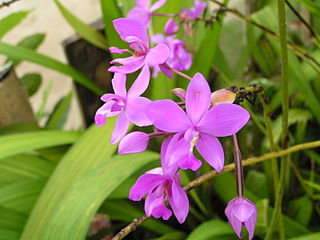
Spathoglottis, commonly known as purple orchids or 苞舌兰属 is a genus of about fifty species of orchids in the family Orchidaceae. They are evergreen terrestrial herbs with crowded pseudobulbs, a small number of leaves and medium-sized resupinate flowers on an upright flowering stem. The sepals and petals are all similar to each other and are white, yellow, pink or purple. Species of Spathoglottis are found from eastern and south-eastern Asia to Australia and some Pacific Islands.
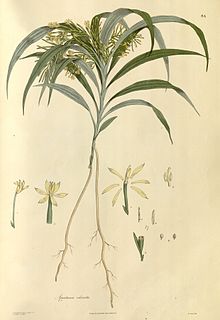
Apostasia, commonly known as grass orchids, is a genus of eight species of primitive orchids in the family Orchidaceae. They are terrestrial, evergreen, grass-like plants, barely recognisable as orchids and are distributed in humid areas of the Himalayan region, China, India, Sri Lanka, Southeast Asia, New Guinea, and Queensland. They have many narrow leaves and small yellow or white, non-resupinate, star-like flowers usually arranged on a branched flowering stem.

Pachystoma, commonly known as kunai orchids or 粉口兰属 , is a genus of two species of flowering plants in the orchid family, Orchidaceae. They are deciduous, terrestrial herbs with one or two linear, pleated or veiny leaves and more or less drooping flowers which do not open widely, on a thin, wiry flowering stem. Species in this genus are found in tropical and subtropical Asia to Australia and islands of the southwest Pacific Ocean.
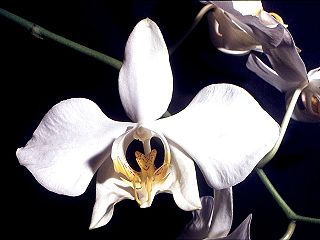
Phalaenopsis amabilis, commonly known as the moon orchid or moth orchid in India and as anggrek bulan in Indonesia, is a species of flowering plant in the orchid family Orchidaceae, native to the East Indies and Australia, and widely cultivated as a decorative houseplant. It is an epiphytic or lithophytic herb with long, thick roots, between two and eight thick, fleshy leaves with their bases hiding the stem and nearly flat, white, long-lasting flowers on a branching flowering stem with up to ten flowers on each branch.

Crepidium, commonly known as 沼兰属 or spur orchids is a genus of about three hundred species of orchids in the family Orchidaceae. Plants in this genus are evergreen, mostly terrestrial plants with short stems lying on the ground, two or more relatively large, pleated leaves and small, non-resupinate flowers with spreading sepals and petals. The genus is widely distributed in the tropics.
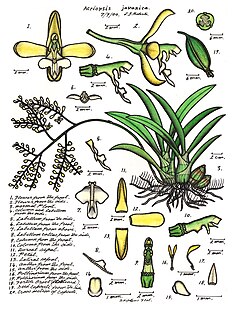
Acriopsis javanica is a species of orchid that is native to Southeast Asia, New Guinea, some Pacific islands and northern Australia. It is a clump-forming epiphyte with dark green leaves and curved, branching flower stems with many white and cream-coloured flowers with purple markings.

Spathoglottis plicata, commonly known as the Philippine ground orchid, or large purple orchid is an evergreen, terrestrial plant with crowded pseudobulbs, three or four large, pleated leaves and up to forty resupinate, pink to purple flowers. It is found from tropical and subtropical Asia to Australia and the western Pacific including Tonga and Samoa.
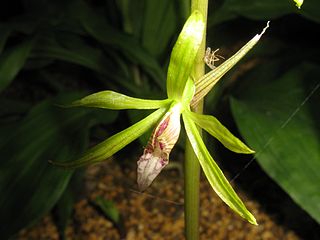
Nervilia concolor, commonly known as the tall shield orchid and as Nervilia aragoana in Australia is a small terrestrial orchid found in South and Southeast Asia and in northern Australia. It has pale green, short-lived flowers with a cream-coloured or yellowish labellum and a more or less circular leaf which emerges at the base of the flowering stem after flowering.

Thelasis, commonly known as fly orchids, is a genus of flowering plants from the orchid family, Orchidaceae. Plants in this genus are usually epiphytes, sometimes lithophytes or rarely terrestrials. Some species have pseudobulbs with up to three leaves, whilst others have several leaves in two ranks. A large number of small, white or greenish yellow flowers are borne on a thin, arching flowering stem. There are about thirty species, distributed from tropical and subtropical Asia to the southwest Pacific.

Hetaeria, commonly known as hairy jewel orchids, is a genus of about thirty species of flowering plants in the orchid family Orchidaceae. Plants in this genus are terrestrial herbs with a succulent rhizome and a loose rosette of leaves. Small, pale, hairy non-resupinate flowers are borne on a thin, hairy flowering stem. They are found in tropical Africa and Asia to New Guinea, Australia and some Pacific Islands.

Taeniophyllum, commonly known as ribbon roots or 带叶兰属 is a genus of about 240 species of epiphytic or lithophytic plants from the orchid family, Orchidaceae. Plants in this genus are more or less leafless with a very short stem and roots that are often flat, green and photosynthetic. The flowers are small, short-lived, flat or tube-shaped and arranged on short, thin flowering stems. Orchids in this genus are found in Africa, tropical and subtropical Asia, New Guinea, Australia and some Western Pacific Islands.
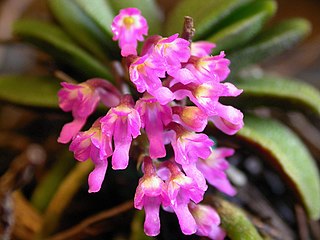
Schoenorchis, commonly known as flea orchids, or 匙唇兰属 , is a genus of flowering plants from the orchid family, Orchidaceae. Plants in this genus are small epiphytes with thin roots, thin leafy stems with leaves in two ranks and tiny fragrant, almost tube-shaped flowers with a prominently spurred labellum. There are about twenty five species found from tropical and subtropical Asia to the Western Pacific.
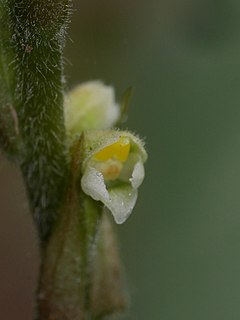
Hetaeria oblongifolia, commonly known as the hairy jewel orchid, is a species of orchid that is native to Southeast Asia, New Guinea and Queensland. It has between four and eight egg-shaped, dark green leaves and up to forty five small, hairy green and white flowers with a deep pouch near the base of the labellum.

Goodyera rubicunda, commonly known as the giant jewel orchid, is a species of orchid that is native to parts of India, Asia, Southeast Asia, New Guinea, Queensland and some Pacific Islands where it grows in damp forest and rainforest. It has between three and six large, egg-shaped leaves and up to ten dull pink and white resupinate flowers that are hairy on the outside.

Pachychila pubescens, commonly known as pink kunai orchid or as 粉口兰 , is a plant in the orchid family. It is native to areas from Asia through Southeast Asia to New Guinea and northern Australia. It is a deciduous, terrestrial herb with one or two grass-like leaves and up to ten dull pink, more or less drooping flowers. It grows in wet, grassy places in forests and woodlands.
Dendrobium convexum, commonly known as the piggyback orchid, is an epiphytic orchid in the family Orchidaceae. It has a creeping, brittle root, erect pseudobulbs with a single leaf on the top and one or two cream-coloured, short-lived flowers with a red and yellow labellum. It is native to Southeast Asia, New Guinea and tropical North Queensland, Australia.

Schoenorchis micrantha, commonly known as the tangled flea orchid, is a small epiphytic orchid that forms small, tangled clumps and has thin stems, many linear leaves and up to thirty small, white, bell-shaped flowers. It is found from Indochina to the south-west Pacific.
Bryobium retusum, commonly known as the Christmas Island urchin orchid, is an epiphytic clump-forming orchid that has oval, fleshy green pseudobulbs, each with two leaves and between seven and twelve short-lived, self-pollinating, pale green, hairy flowers. This orchid is found between Java and New Caledonia.
Thelasis capitata, commonly known as the conical fly orchid, is a plant in the orchid family. It is a clump-forming epiphyte with flattened pseudobulbs, each with a single strap-shaped leaf. A large number of small yellowish green flowers are arranged in a cone shape on a thin but stiff flowering stem. This orchid is found from Thailand to Malesia, including on Christmas Island.
Phreatia micrantha, commonly known as the native fan orchid, is a plant in the orchid family and is an epiphyte or lithophyte with four to ten channelled leaves in a fan-like arrangement with their bases sheathing the stem. A large number of small white, cup-shaped flowers are arranged along a thin, wiry flowering stem. This orchid is native to areas between Papuasia and the western Pacific.

















